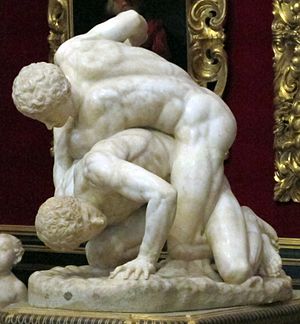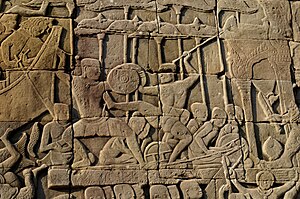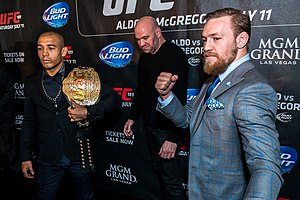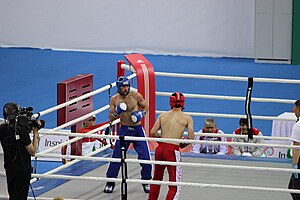Combat sport

A combat sport, or fighting sport, is a contact sport that usually involves one-on-one combat. In many combat sports, a contestant wins by scoring more points than the opponent, submitting the opponent with a hold, disabling the opponent (knockout, KO), or attacking the opponent in a specific or designated technique. Combat sports share a long history with the martial arts.
Some combat sports (and their national origin) include boxing (Greek-British), Brazilian jiu-jitsu (Japanese-Brazilian), catch wrestling (British-American), jujutsu (Japanese), judo (Japanese), freestyle wrestling (British-American), Greco-Roman wrestling (French), karate (Chinese-Okinawan-Japanese), kickboxing (numerous origins, mainly Southeast Asian), Lethwei (Burmese), mixed martial arts (numerous origins), Muay Thai (Thai), sambo (Soviet/Russian), sanda (Chinese), savate (French), taekwondo (Korean), Vale Tudo (Brazilian), pankration (Ancient Greek), luta livre (Brazilian), and folk wrestling (various).
History[edit]


Traditional styles of wrestling exist in most cultures; wrestling can be considered a cultural universal. Boxing contests date back to ancient Sumer in the 3rd millennium BCE and ancient Egypt circa 1350 BCE.[1] The ancient Olympic Games included several combat-related sports: armored foot races, boxing, wrestling, and pankration, which was introduced in the Olympic Games of 648 BCE.
In ancient China, combat sport appeared in the form of lei tai. It was a no-holds barred combat sport that combined boxing and wrestling. There is evidence of similar combat sports in ancient Egypt, India and Japan.[2]
Through the Middle Ages and Renaissance, the tournament was popular. Tournaments were competitions that featured several mock combat events, with jousting as a main event. While the tournament was popular among aristocrats, combat sports were practiced by all levels of society. The German school of late medieval martial arts distinguished sportive combat (schimpf) from serious combat (ernst). In the German Renaissance, sportive combat competitions were known as Fechtschulen, corresponding to the Prize Playing in Tudor England. Out of these Prize Playing events developed the English boxing (or prizefighting) of the 18th century, which evolved into modern boxing with the introduction of the Marquess of Queensberry rules in 1867.
Amateur boxing has been part of the modern Olympic Games since their introduction in 1904. Professional boxing became popular in the United States in the 1920s and experienced a "golden age" after World War II.
The creation of Brazilian jiu-Jitsu is attributed to the Gracie family of Brazil in 1925 after Asian martial arts were introduced to Brazil. Vale-tudo, wrestling, Muay Thai kickboxing and luta livre gained popularity. Modern Muay Thai was developed in the 1920s to 1930s. Sambo was introduced in the Soviet Union. Modern Taekwondo also emerged after the Japanese occupation of Korea and became an Olympic sport in 2000. Sanshou as part of modern wushu was developed in the People's Republic of China since the 1950s. Kickboxing and full contact karate were developed in the 1960s and became popular in Japan and the West during the 1980s and 1990s. Modern MMA developed out of the interconnected subcultures of Vale Tudo and shoot wrestling. It was introduced in Japan in the form of Shooto in 1985, and in the United States as Ultimate Fighting Championship (UFC) in 1993. The Unified Rules of Mixed Martial Arts were introduced in 2000, and the sport experienced peak popularity in the 2000s. During this period, multiple brands and promotions were established. The most well-known promotion for MMA is UFC.

Popularity by gender[edit]

Combat sports are generally more popular among men as athletes and spectators. For many years, participation in combat sports was practically exclusive to men; USA Boxing had a ban on women's boxing until 1993.[3] A study conducted by Greenwell, Hancock, Simmons, and Thorn in 2015 revealed that combat sports had a largely male audience.[4]
List[edit]
Unarmed[edit]
Striking[edit]
- Boxing and Kickboxing
- Amateur Boxing
- Bare-knuckle Boxing
- Greek Boxing
- Roman Boxing
- English Boxing
- American Boxing
- Russian Boxing
- Chivarreto Boxing
- Dambe Boxing
- Musangwe Boxing
- Filipino Boxing
- Cuban Boxing
- Puerto Rican Boxing
- Japanese Boxing
- Mexican Boxing
- Australian Boxing
- Irish Boxing
- Armenian Boxing
- K-1 Kickboxing
- Japanese Kickboxing
- Korean Kickboxing
- American Kickboxing
- Light Contact Kickboxing
- Semi Contact Kickboxing
- Full Contact Kickboxing
- Dutch Kickboxing
- Freestyle Kickboxing
- European Kickboxing
- Kick Light Kickboxing
- Savate Kickboxing
- Unified Rules Kickboxing
- Adimurai Kickboxing
- Enfusion Kickboxing
- Glory Kickboxing
- Bando Kickboxing
- New Zealand Kickboxing
- Karate
- Kyokushin
- Shotokan
- Yoshukai
- Bōgutsuki
- Goju-ryu
- Shito-ryu
- Chito-ryu
- Isshin-ryū
- Uechi-ryu
- Shorin-ryu
- Ryūei-ryū
- Shōrei-ryū
- Shohei-ryu
- Tōon-ryū
- Kenyu-ryu
- Tokitsu-Ryu
- Kuma-ryu
- Washin-ryu
- Shōrinji-ryū
- Yoseikan-ryu
- Shidōkan-ryu
- Matsubayashi
- Seidokaikan
- Shōrinkan
- Kyudōkan
- Genseiryu
- Shukokai
- Shudokan
- Bōgutsuki
- Fudokan
- Budokan
- Seido Juku
- Sankukai
- Meibukan
- Gohakukai
- Koei Kan
- Wushu
- Taekwondo and Tang Soo Do
- Suntukan
- Sikaran
- Capoeira
- Engolo
- Taido
Grappling[edit]
- Folk wrestling
- Sumo
- Cornish wrestling
- Cumberland Wrestling
- Westmorland wrestling
- Lancashire wrestling
- Devon wrestling
- Collar-and-elbow wrestling
- Iranian wrestling
- Khmer traditional wrestling
- Canarian wrestling
- Leonese wrestling
- Kazakh wrestling
- Backhold wrestling
- Buno
- Bultong
- Lutte Traditionnelle
- Jobbarer Boli Khela
- Narodno rvanje
- Gatta Gusthi
- Karakucak
- Schwingen
- Pehlwani
- Ristynės
- Ssireum
- Ringen
- Galhofa
- Calegon
- Pelivan
- Bokh
- Buriad bokh
- Bukh noololdoon
- Gorës
- Gushtingiri
- Gouren
- Barróg
- Glima
- Naban
- Dumog
- Alysh
- Khridoli
- Chidaoba
- Kurash
- Khuresh
- Tegumi
- Kene
- Malakhra
- Mukna
- Vajra-mushti
- Huka-huka
- Coreeda
- Sa Strumpa
- Norfolk wrestling
- Kragkast
- Calegon wrestling
- Pakištynės
- Trântă
- Tigel
- Southern Mongolian wrestling
- Mariwariwosu
- Vật cổ truyền
- Boumwane
- Hokoko
- Rongomamau
- Moana wrestling
- Epoo Korio
- Fagatua
- Popoko
- Veibo
- Taupiga
- Uma wrestling
- Modern wrestling
- Jujutsu and Judo
- Japanese jiu-jitsu
- Sport jujutsu
- International jiu-jitsu
- Gracie ju-jitsu
- Machado ju-jitsu
- Brazilian jiu-jitsu
- 10th Planet jiu-jitsu
- Guerrilla jiu-jitsu
- American Jiu-Jitsu
- Hakko-ryu jiu-jitsu
- Gyokushin-ryū Jujutsu
- Shorinji Kan Jiu Jitsu
- Kodokan Judo
- Kosen Judo
- Freestyle Judo
- Azerbaijani Judo
- Israeli Judo
- Mongolian Judo
- French Judo
- Georgian Judo
- Russian Judo
- Korean Judo
- Brazilian Judo
- Kung Fu
- Sambo
- Luta Livre Esportiva
- Aikido
Hybrid[edit]
- Mixed martial arts
- Karate
- Kenko Kempo Karate
- Shidokan Karate
- Tenshinkan Karate
- Tsuroka Karate
- Ashihara kaikan
- Enshin kaikan
- Byakuren Kaikan
- Kendokai Kendokan
- Shōrinjiryū Kenkōkan
- Okinawa Seidokan
- Shindo Jinen-ryu
- Shōbayashi Shōrin-ryū
- Wado-ryu
- Shuri-ryu
- Gosoku-ryu
- Sankukai
- Sanshinkai
- Zendokai
- Nanbudo
- Kokondo
- Kansuiryu
- Seigokan
- Boxing and Kickboxing
- Jujutsu and Judo
- Aikido
- Modern Wrestling
- Wushu
- Taekwondo and Taekkyon
- Kempo
- Folk wrestling
- Sambo
- Pankration
- Gaidojutsu
- Kajukenbo
- Vale tudo
- Luta Livre
- Kudo
- Combat Hopak
- Angampora
Armed[edit]
Techniques[edit]
The techniques used can be categorized into three domains: striking, grappling, and weapon usage, with some hybrid rule-sets combining striking and grappling. In combat sports the use of these various techniques are highly regulated to minimize permanent or severe physical damage to each participant though means of organized officiating by a single or multiple referees that can distribute penalties or interrupt the actions of the competitors during the competition. In weapon based sports, the weapons used are made to be non-lethal by means of modifying the striking portions of the weapon and requiring participants to wear protective clothing/armor.
Olympics[edit]
This section needs to be updated. (July 2021) |
- Amateur boxing (1904–2020): Boxing has been staged at every summer Olympic games since 1904 except Stockholm in 1912 due to Swedish law.[5]
- Judo (1964, 1972–2020): Judo was not included in the 1968 Mexico City summer Olympics. Women's judo was added to the Olympics in 1992 in Barcelona.[6]
- Taekwondo (1988 Seoul Games as demonstration sport, 2000–2020): Became an official medal sport at the 2000 Sydney Olympic Games.[7]
- Wrestling Greco-Roman (1908–2020): The first form of wrestling to be held at the Olympic Games.[8]
- Wrestling Freestyle (1920–2020): Was modified at the 2000 Sydney Games and reduced the amount of weight categories provided.[9]
- Pankration and singlestick are two other forms of combat sports that have been included in the Olympics. These combat sports were introduced to the Olympic Games in the early 1900s however singlestick was only represented at the 1904 Olympic games and pankration whilst lasting four centuries in Ancient Greek Olympia's, was not included at all after 1900.
- Fencing (1896–2020): Competitive fencing is one of the five activities which have been featured in every modern Olympic Games, the other four being athletics, cycling, swimming, and gymnastics.
- Olympic dueling (1906–1908): Demonstration sport at the 1906 Olympics and 1908 Olympics.
- Karate (2020): Karate made its Olympic debut for Tokyo 2020 under new IOC rules.
Protective gear and clothing[edit]
In combat sports, victory is obtained from blows, punches or attacks to the head to a point of physical injury that the opponent is unable to continue.[10] Different forms of combat sport have different rules and regulations into the equipment competitors have to wear. In Amateur boxing seen at the Olympics, competitors are permitted to wear head guards and correctly weighted padded gloves, mouth guards are optional and the canvas floor protection from a hard fall.[11] In sports such as Taekwondo, competitors are permitted to wear a trunk protector, head guard, gloves, groin guard and shin and forearm pads.[12] Professional boxing and MMA are two of the most dangerous combat sports in the world due to the lack of protective gear worn (compared to the protected fists). Competitors in these two sports have the option to wear a mouthguard and must wear suitable gloves. The lack of protective clothing makes competitors vulnerable to concussions and further traumatic head injuries. A scientific experiment, conducted last year[when?] by Dr Andrew McIntosh of ACRISP at the Federation University of Australia, tested the impact of seven different head guards in combat sport. The results of the experiment revealed the benefits of the combination of a glove and headguard in maximising the impact energy attenuation.[13] A study conducted by Lystad showed that combat sports with little to no protective gear such as MMA or boxing has an injury incidence rate range of 85.1–280.7 per 1000 athletes in comparison to another striking combat sport like Taekwondo which has a large amount of protective gear such as pads, headgear, mouth guard and gloves, has an injury incidence rate range of 19.1–138.8 per 1000 athletes. This means that injury rates are drastically lowered when protective gear is used.[14]
Gear includes:
- Gloves
- Headgear
- Mouthguard
- Shin guards
- Arm guards
- Groin guard
- Trunk guard
- Wraps (material wrapped around the hand and wrist (and/or foot and ankle) that provides added alignment, support and protection)
Fighting area[edit]
- Mat
- circular layout or rectangular layout
- Ring
- with ropes around the fighting area
- boxing ring
- without ropes around the fighting area
- pit: A circle 27 feet in diameter, of which the inner 24 feet is colored blue. The next 3 feet is yellow, which is the caution area. When the fighter gets to the yellow area, he know they are getting close to stepping out-of-bounds. The last edge of the ring is the red zone, which features a 30-degree upward angle. When a fighter steps on the red area, they are stepping up slightly, letting them know they are out-of-bounds.
- sumo ring (dohyō), sand ring
- Fenced area (generically referred to as a "cage")
- Can be round or have at least six sides. The fenced area is generally called a cage or more precisely, depending on the shape, a hexagon (if it has 6 sides) or an octagon (if it has 8 sides).
- Some replace the metal fencing with a net.
See also[edit]
- Blood sport
- Hand-to-hand combat
- Hoplology
- List of boxing films
- List of martial arts films
- Mixed martial arts
References[edit]
- ^ "Boxing". Encyclopedia Britannica. Retrieved May 12, 2018.
- ^ Brownell, Susan Elaine (1990). The olympic movement on its way into Chinese culture. University of California, Santa Barbara. pp. 29, 63.
In both ancient China and Greece, the most popular sports were probably wrestling, boxing, and combinations thereof (Greek pankration, Chinese leitai). The same might be argued for ancient Egypt, India and Japan. [...] In both ancient China and Greece, the no-holds-barred combat sport (Greek pankration, Chinese leitai) was probably the most popular one.
- ^ "History of Amateur Boxing". Team USA. Archived from the original on April 24, 2012. Retrieved 2018-03-21.
- ^ Greenwell, Hancock, Simmons, Thorn (2015). "The effects of gender and social roles on the marketing of combat sport". Sport Marketing Quarterly. 24 (1): 19. ISSN 1061-6934.
{{cite journal}}: CS1 maint: multiple names: authors list (link) - ^ "Boxing Equipment, History and Rules | Olympic.org". Retrieved 2016-05-17.
- ^ "Judo Equipment, History and Rules | Olympic.org". Retrieved 2016-05-17.
- ^ "Taekwondo Equipment, History and Rules | Olympic.org". Retrieved 2016-05-17.
- ^ "Wrestling Greco Roman Equipment, History and Rules | Olympic.org". Retrieved 2016-05-17.
- ^ "Wrestling Freestyle Equipment, History and Rules | Olympic.org". Retrieved 2016-05-17.
- ^ "Combat Sport - 2015". Australian Medical Association. 2015-11-21. Retrieved 2016-05-17.
- ^ "Boxing Equipment, History and Rules | Olympic.org". www.olympic.org. Retrieved 2016-05-17.
- ^ "Taekwondo Equipment, History and Rules | Olympic.org". www.olympic.org. Retrieved 2016-05-17.
- ^ McIntosh, A. S.; Patton, D. A. (2015). "Sign In". British Journal of Sports Medicine. 49 (17): 1113–7. doi:10.1136/bjsports-2015-095093. PMID 26192195. S2CID 25246456.
- ^ Lystad, Reidar (2015). "Epidemiology of injuries in full-contact combat sports". Australasian Epidemiologist. 22.
